It can be scary when your dog has a seizure, and difficult to keep calm. If your dog just seized and you’re waiting on a veterinary appointment, you may be wondering about the reasons dogs have seizures or how to help.
Seizures in dogs can be caused by poisoning, underlying illness, brain tumors, brain damage, heatstroke, nutritional deficiencies, and heartworm. If your dog has a seizure, do your best to time and videotape it. Call your veterinarian for help.
Many times, you can wait for an appointment with your primary veterinarian after a seizure. However, sometimes seizures are emergent. Please call an emergency vet clinic if your dog has more than one seizure in 24 hours or a seizure lasting over three minutes.
If you suspect poisoning, brain trauma, or heatstroke, your dog needs to see an emergency vet right away.
In this article, we’ll discuss 12 reasons dogs have seizures and how you can help them.
#1: Idiopathic Epilepsy

Idiopathic epilepsy is a genetic condition that causes seizures in dogs.
©Catalina Arango/Shutterstock.com
Also known as primary epilepsy, idiopathic epilepsy is the most common cause of seizures in young dogs. Idiopathic epilepsy’s cause is unknown, but we do know that it’s genetic.
Breeds most likely to inherit epilepsy include Bull Terriers, herding dogs, retrievers, and brachycephalic (short-snouted) breeds.
Dogs can also have secondary epilepsy, meaning their epilepsy is a symptom of another primary condition. It’s important for your veterinarian to rule out secondary epilepsy before diagnosing your dog with idiopathic epilepsy. This requires testing and diagnostics.
#2: Poisoning

Alcohol and other toxins can cause seizures if consumed.
©Claire Lucia/Shutterstock.com
Poisoning is one of the top reasons for seizures in dogs. According to Southeast Veterinary Neurology, the following toxins can cause seizures in dogs:
- Alcohol (including both alcoholic beverages and other items containing alcohol, such as antifreeze)
- Animal toxins such as from Bufo Toads or Killer Bees
- Carbon monoxide
- Foods such as chocolate, caffeine, or foods containing the sweetener xylitol
- Excess salt, such as that found in Play-Dough or saltwater (while dogs need salt in their diet, too much can cause poisoning)
- Heavy metals such as lead or zinc (which is found in pennies)
- Drugs and medications
- Pesticides
- Toxic plants
Poisoning that causes a dog to have a seizure is considered an emergency medical situation. Please call your nearest emergency vet clinic, or see if your primary vet is open and takes emergency appointments. Do not wait to have your dog seen.
#3: Liver Disease
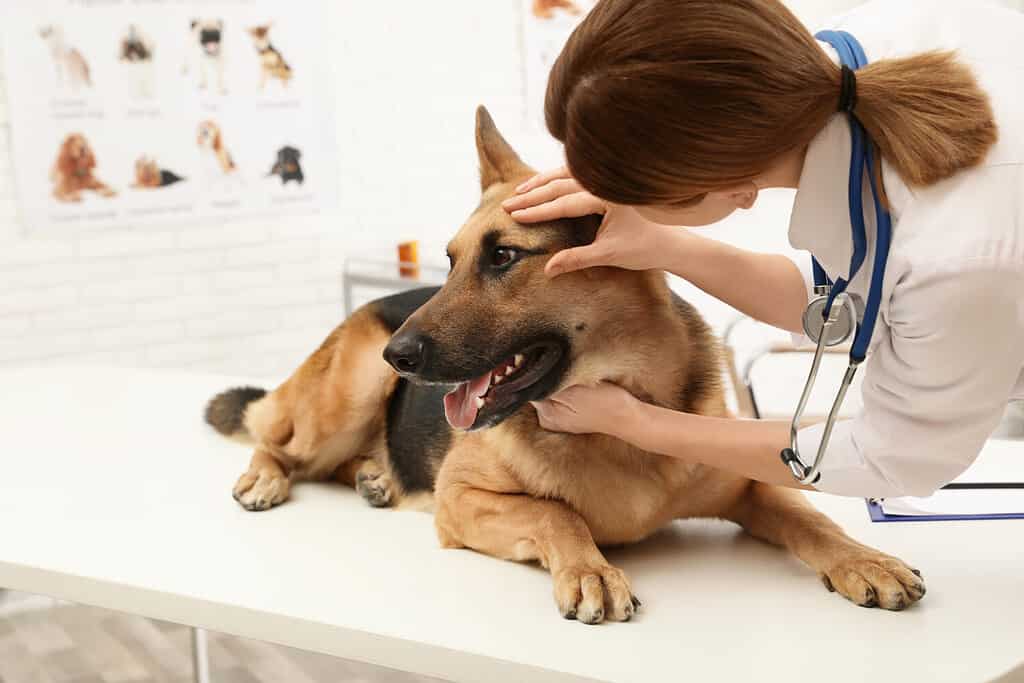
Seizures can also be a symptom of liver disease.
©New Africa/Shutterstock.com
Liver disease in dogs can cause neurological problems in dogs, including seizures. Liver disease occurs when the liver is damaged, typically by poisoning, medications, or infections.
According to Merck Veterinary Manual, symptoms of liver disease in dogs include:
- Poor appetite
- Weight loss
- Vomiting
- Stomach ulceration
- Diarrhea
- Seizures
- Neurological problems
- Fever
- Blood clotting problems
- Gastrointestinal bleeding
- Jaundice
- Fluid in the abdomen
- Excessive thirst and urination
- Changes in the size of the liver
Your veterinarian can diagnose your dog with liver disease using blood tests, imaging, and biopsies.
When a dog’s liver is damaged, it can regenerate, but sometimes not quickly enough–especially if the damage is ongoing. Prompt treatment gives them the best chances of recovery.
#4: Kidney Failure
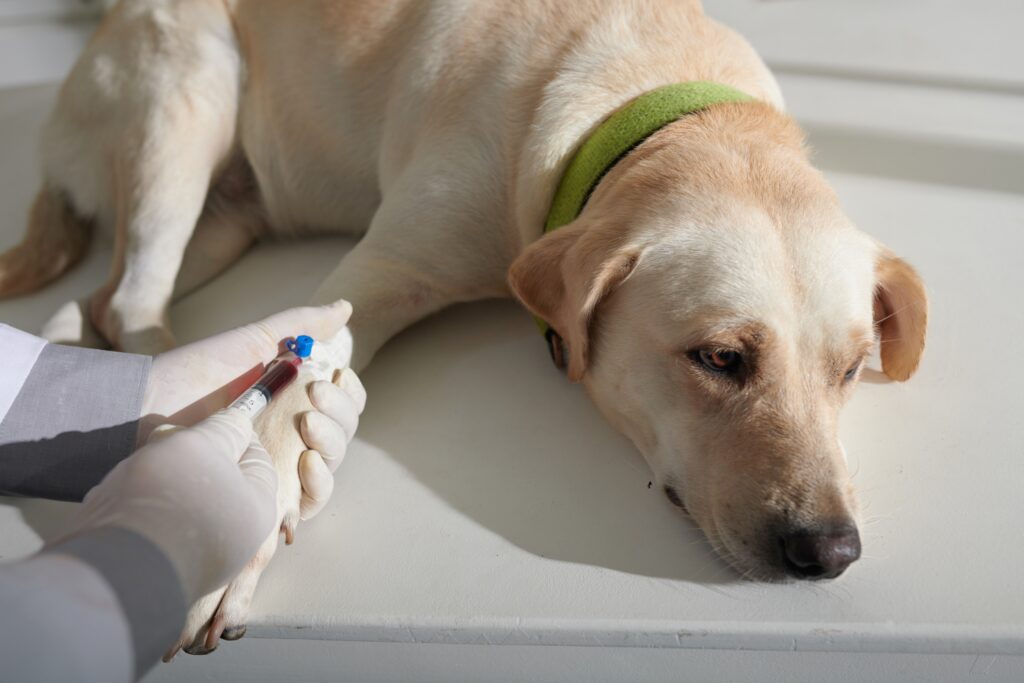
Kidney failure can cause seizures alongside excessive thirst and urination, and other symptoms.
©Dragon Images/Shutterstock.com
Kidney failure happens when a dog’s kidneys are no longer functioning well enough to filter toxins from their blood. Kidney failure can both cause seizures and be caused by seizures.
Symptoms of kidney disease include:
- Excess thirst and urination
- Decreased appetite
- Tiredness
- Vomiting
- Diarrhea
- Bad breath
- Mouth Ulcers
- Seizures
Kidney disease can be diagnosed via blood and urine tests at the vet. Treating kidney disease early gives your dog the best chance at a longer, healthier life with fewer complications.
#5: Brain Tumors
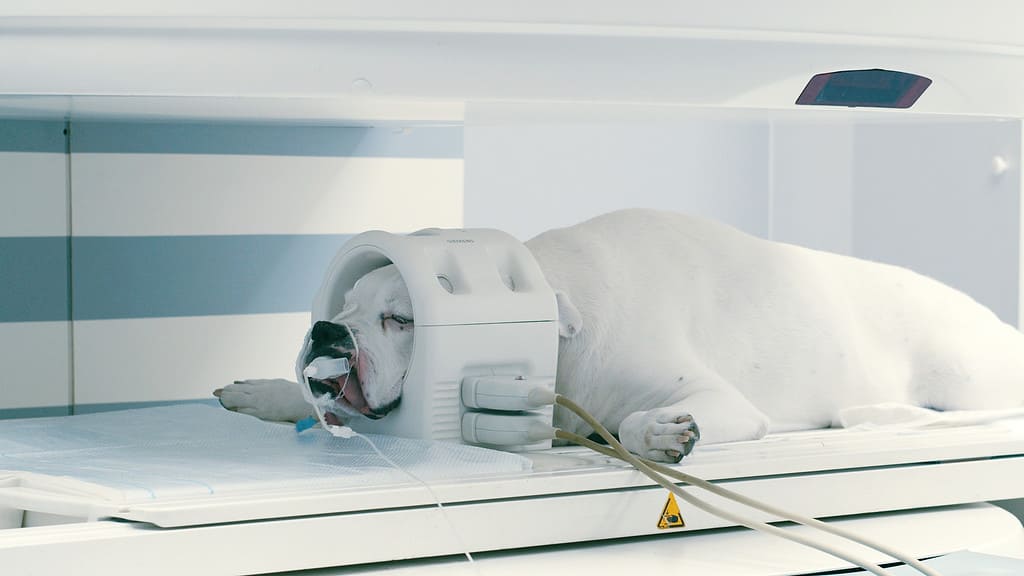
Brain tumors, both benign and cancerous, can lead to seizures and other neurological problems.
©CameraCraft/Shutterstock.com
There are two types of brain tumors in dogs. Primary brain tumors initiate in the brain, while secondary tumors spread from other parts of the body. Brain tumors can be cancerous but aren’t always.
Meningiomas, which are a type of benign brain tumor, are most commonly seen in long-snouted breeds such as Collies. Meanwhile, pituitary gland tumors and glial cell tumors are more often seen in short-snouted breeds.
Symptoms of brain tumors include:
- Abnormal behaviors
- Changes in vision
- Walking in circles
- Wobbly walking
- Head tilt
- Neck pain
- Seizures
Your veterinarian can diagnose the type of tumor your dog has based on various forms of testing and can give you a treatment plan–which may vary from chemotherapy or neurosurgery to simply keeping your dog comfortable for the remainder of their lives.
#6: Trauma to the Brain

Head injuries can lead to brain trauma in dogs.
©Hryshchyshen Serhii/Shutterstock.com
Any trauma or damage to the brain can cause seizures. For the most part, you will know if your dog has been hurt in this way. Maybe they were in the car during an accident or fell and hit their head.
If your dog has seizures after an injury, it’s important to get them to the vet right away.
#7: Heat Stroke

Short-snouted dogs like Pugs are more likely to have seizures as a result of heat stroke.
©TatyanaPanova/Shutterstock.com
Heat stroke in dogs is a medical emergency caused by elevated body temperature. You’ll most often see heat stroke in dogs who have been left in a hot car or after strenuous exercise in hot weather.
Symptoms of heat stroke in dogs include:
- Excessive panting or drooling
- Bloody diarrhea
- Vomiting
- Weakness
- Confusion
- Seizures
- Collapse
- Shock
- Organ damage
- Blood clotting problems
Short-snouted, or brachycephalic, breeds are most prone to heat stroke. Large breeds are also more at risk.
If you suspect your dog has had a heat stroke, please call your nearest emergency vet clinic or see if your primary vet takes on emergency patients.
#8: Thiamine Deficiency

Dogs eating a homemade diet are most likely to suffer from seizures as a result of thiamine deficiency.
©Filmbildfabrik/Shutterstock.com
Thiamine, or vitamin B1, helps a dog’s metabolism and cell health. If they’re deficient in this key nutrient, dogs first show gastrointestinal symptoms such as poor appetite, upset stomach, and weight loss. They will then go on to have neurological symptoms, which can include seizures as well as uneven pupils, and a decreased response to light. They may even have cardiothoracic issues if the deficiency is severe.
If your dog is eating storebought kibble, especially those from large brands, they’re very unlikely to develop nutritional deficiencies. However, there have been recalls in the past due to dog foods not containing enough thiamine.
Homemade diets are much more likely to cause nutritional deficiencies, and it’s essential to work with a certified veterinary nutritionist if you want to make your dog’s food yourself. (Please note that “pet nutritionist” is a label anyone can use, so they must be board-certified to ensure they have the proper qualifications.)
#9: Diabetes or Low Blood Sugar
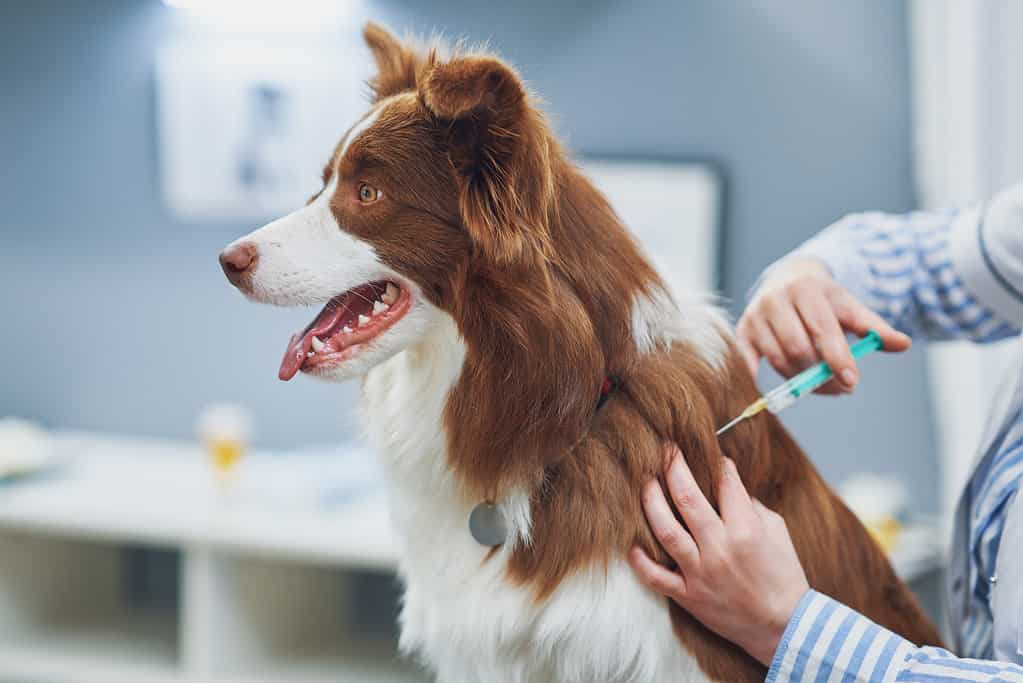
Diabetes and low blood pressure can cause seizures in dogs if left untreated.
©iStock.com/macniak
Diabetes in dogs happens when their bodies don’t process glucose as they should. Symptoms of diabetes in dogs include:
- Increased thirst and urination
- Increased or decreased appetite
- Weight loss, even with an increased appetite
- Cloudy eyes
- Chronic or repeat infections
Without treatment, diabetes can cause neurological symptoms such as seizures and even comas in dogs.
Vets diagnose diabetes using blood and urine tests. While diabetes cannot be cured, it can be managed, and many dogs go on to live long and healthy lives.
#10: Heartworm

Heartworm can rarely move to other areas of the body, such as the brain, and cause seizures.
©vitrolphoto/Shutterstock.com
Heartworm is a rare cause of seizures in dogs, but it’s possible. Since the heartworm test is simple and commonly performed, it’s worth asking your veterinarian about heartworm if your dog is having seizures.
Heartworm is a parasite transferred by mosquitos, which can carry larvae after drinking blood from infected animals.
Dogs with small numbers of heartworm can be asymptomatic, but symptoms typically escalate as the worms reproduce. The most common symptoms include:
- Coughing
- Fatigue
- Decreased appetite
- Weight loss
- Heart failure
- Blocked blood flow
Heartworm is easy to prevent but painful to treat, so it’s best to have your dog on parasite-preventative medication that prevents heartworms and keep them on it year-round.
If you think your dog has heartworm, please schedule an appointment with your veterinarian. Heartworm can be fatal, especially when left untreated.
#11: Canine Distemper Virus (CDV)
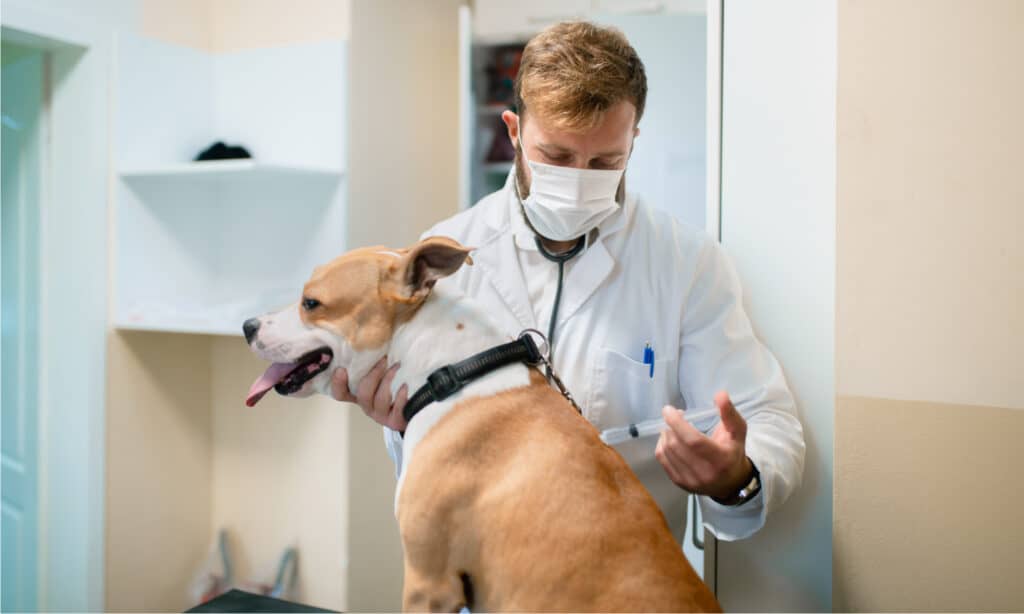
Canine distemper is a serious condition that can cause dogs to seize.
©StrDr stock/Shutterstock.com
Canine distemper virus, or CDV, impacts dogs’ respiratory, gastrointestinal, and nervous systems. Once the disease progresses to attacking the nervous system, seizures are possible.
Symptoms of canine distemper include:
- Eye and nose discharge
- Fever
- Coughing
- Lethargy
- Decreased appetite
- Vomiting
- Head tilt
- Muscle spasms
- Jaw convulsions
- Seizures
- Paralysis
- Thickened paw pads
All dogs can develop CDV, but puppies and unvaccinated adult dogs are most susceptible. This is a serious disease, so prompt veterinary care is a must.
Unfortunately, the prognosis for canine distemper is poor, which is why vaccinating your dog at a young age is so important!
#12: Rabies
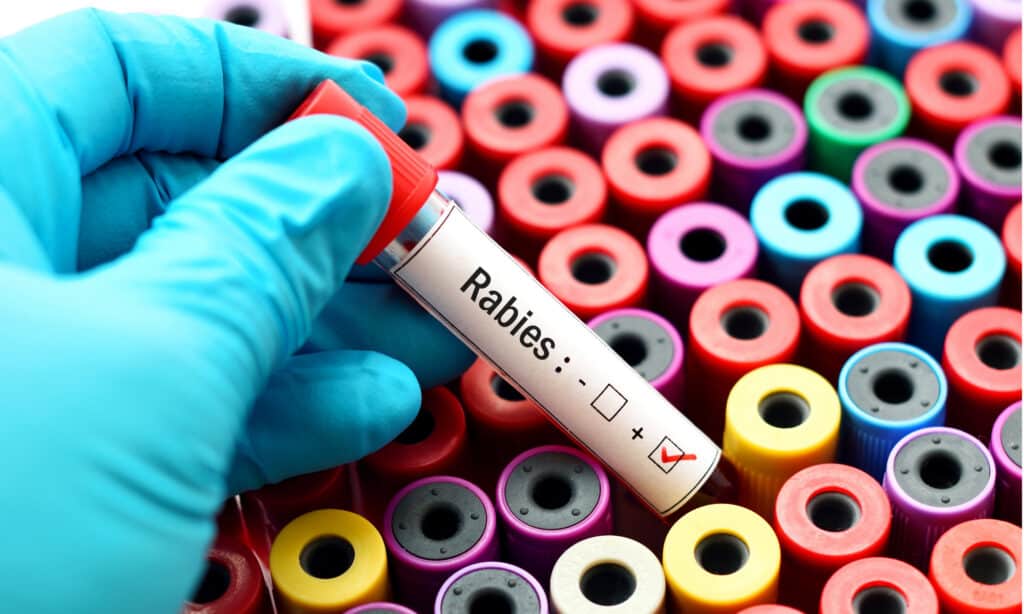
Rabies isn’t common in vaccinated dogs or dogs kept indoors, but it can cause seizures.
©iStock.com/arun011
Rabies typically occurs when an unvaccinated dog is bitten by an infected animal. Dogs with up-to-date rabies vaccines are very unlikely to develop it, as are dogs kept inside and away from wildlife and other potentially-infected animals.
There are two types of rabies in dogs: furious rabies and dumb rabies. Furious rabies is the least common and typically ends in death by seizure. Other symptoms of furious rabies include aggressive or excitable behavior, increased appetite, pica (eating non-food items), and paralysis.
Dumb rabies causes progressive paralysis, which typically begins with the limbs, face, and throat and ends in a coma before the dog dies.
Rabies is highly contagious and deadly. If you think your dog has rabies, it’s important to consult a veterinarian as well as human doctors–everyone who came into contact with your dog should have rabies vaccines. Rabies isn’t only transferred when a dog bites but can also be caught through contact with their saliva.
How to Spot and Time Seizures in Dogs
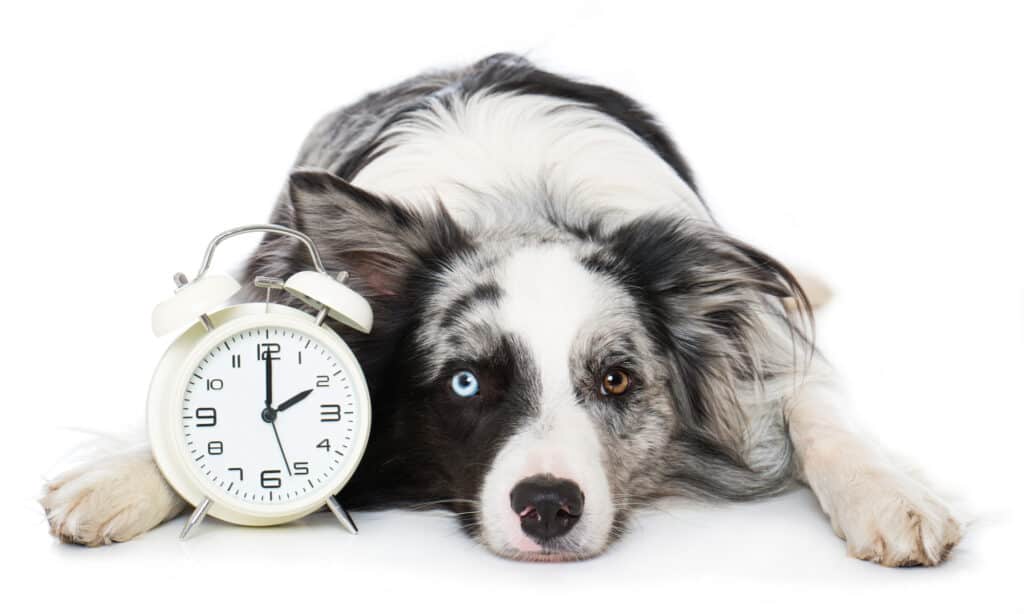
It’s important to time your dog’s seizures and record the date, time of day, and length of the seizure each time.
©Dora Zett/Shutterstock.com
Now that we’ve discussed the reasons your dog might have seizures let’s talk about what they look like and how to record them. This will help your vet get a clearer picture of your dog’s health and may help identify a pattern of your dog’s seizures.
There are three phases of seizures in dogs:
- Pre-ictal phase: Your dog will likely behave anxiously as if they can feel a seizure coming. They may pace, whine, or seek comfort. This can last seconds or hours before the seizure occurs.
- Ictal phase: This is the seizure itself and when you should start timing. Most seizures last seconds or minutes. Seizures and dogs can be subtle with symptoms like trembling, lip licking, staring, or appearing dazed or confused. They can also cause easier-to-spot symptoms like collapse and erratic movements. Your dog may pee or poop during a seizure, or they may salivate excessively.
- Post-ictal phase: After the seizure, your dog may seem confused or restless. They may drool excessively or become blind temporarily. This does not count toward the amount of time your dog is seizing.
Your veterinarian can work with you to determine what each of these phases looks like in your dog so that you can monitor their seizures as accurately as possible.
If you’re unsure, you can try to record your dog’s seizure for your vet. This can both confirm that they’re experiencing seizures, help you to know how long they last, and help your vet to explain what each phase looks like.
Should I Worry if my Dog had a Seizure?
Some dogs have one unexplained seizure, with no other symptoms or seizures following. However, you should always notify your vet immediately after your dog seizes.
They may suggest that you bring your dog in for an exam or simply note the seizure and have you monitor your dog for more in the future.
If your dog has more than one seizure in a month, they must see a veterinarian for diagnosis and treatment.
Multiple seizures in a single day or any seizure lasting over three minutes warrants an emergency vet visit. If you suspect your dog has eaten something toxic, they should also see an emergency vet immediately.
How to Help a Dog With Seizures

Comforting your dog after their seizure has passed can help them as they recover.
©iStock.com/Monoliza21
Here are some ways to help your dog when they’re having seizures:
- Time the seizure. Seizures lasting over three minutes are emergent, and you should call your nearest emergency vet clinic for help.
- Record the seizure. Showing this to your vet later on can help with a diagnosis and can also remind you how long your dog was seizing and how it presented.
- Stay away from your dog’s head. During a seizure, your dog isn’t themselves. Even docile dogs may bite.
- Don’t put anything in their mouth. You can be bitten or cause your dog to choke. They will not swallow their tongues–this is a myth.
- Keep them safe. As best as you can, ensure your dog doesn’t hurt themselves. You may need to move them to the floor, away from stairs, or remove sharp objects from the surrounding area. Be careful so that you aren’t bitten.
- Don’t hold them down. This can cause injury to yourself or your dog.
After the seizure, you can watch your dog to ensure they’re okay and don’t have more seizures. Comfort them however they prefer, whether they want to cuddle or just sit nearby.
Try to remain calm so that your dog doesn’t panic. Remember to write down when and how long your dog seized.
If seizures are new for your dog, try thinking about the cause–have they been acting strange lately or had any other symptoms? Could they have eaten something toxic?
Lastly, call your veterinarian and let them know your dog had a seizure. Follow up however your vet recommends.
They may prescribe medications to reduce your dog’s seizures or recommend testing for or treating an underlying condition.
Summary of Reasons Dogs Have Seizures
| Cause | What to do |
| Idiopathic epilepsy | Your veterinarian will rule out other causes and likely prescribe medication |
| Poisoning | See an emergency vet immediately |
| Liver disease | Visit the vet as soon as possible for diagnosis and treatment |
| Kidney failure | Visit the vet as soon as possible for diagnosis and treatment |
| Brain tumor | Visit the vet as soon as possible for diagnosis and treatment |
| Trauma to the brain | See an emergency vet immediately |
| Heatstroke | See an emergency vet immediately |
| Thiamine (vitamin B1) deficiency | Visit the vet as soon as possible for diagnosis and treatment, change your dog’s diet to cover all necessary nutrients |
| Diabetes or low blood sugar | Visit the vet as soon as possible for diagnosis and treatment |
| Heartworm | Visit the vet as soon as possible for diagnosis and treatment |
| Canine distemper virus (CDV) | Visit the vet as soon as possible for diagnosis and treatment |
| Rabies | Seek veterinary help as well as help for any animals or humans who’ve interacted with the dog |
Thank you for reading! If you have feedback on this post, please contact the AZ Animals editorial team.
The photo featured at the top of this post is © Daxiao Productions/Shutterstock.com
Ready to discover the top 10 cutest dog breeds in the entire world?
How about the fastest dogs, the largest dogs and those that are -- quite frankly -- just the kindest dogs on the planet? Each day, AZ Animals sends out lists just like this to our thousands of email subscribers. And the best part? It's FREE. Join today by entering your email below.
Thank you for reading! Have some feedback for us? Contact the AZ Animals editorial team.






